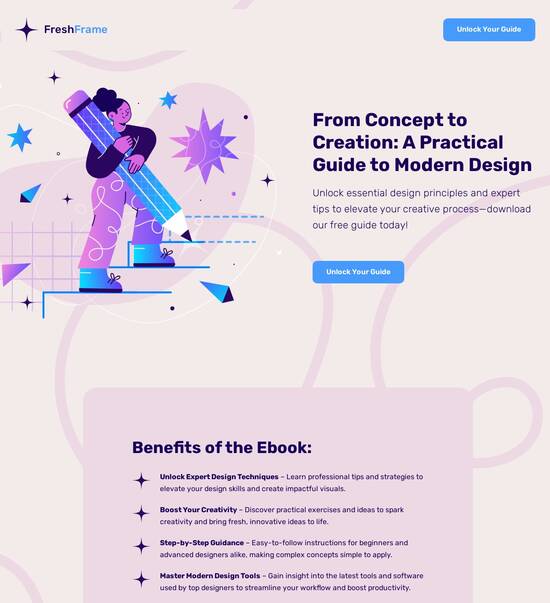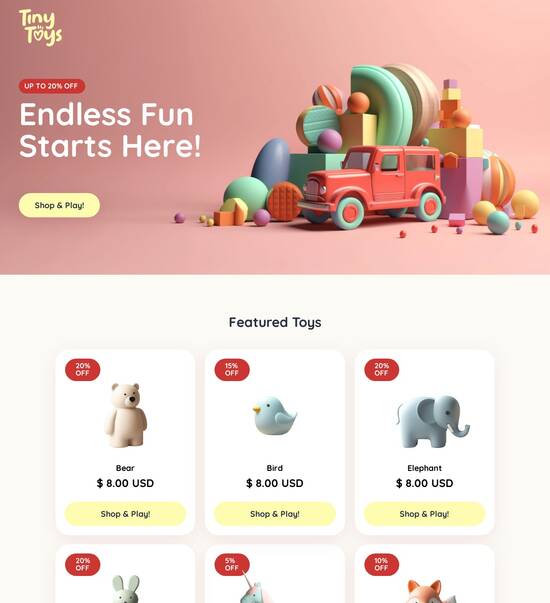
HTML page template for retro game stores
Use TemplateAbout template
Showcase your products with stunning landing page templates for your retro game stores. Ready to boost those sales?
Recommended templates

Easy to build without coding
With the intuitive drag-and-drop builder, anyone on your team can create high-converting pages without any knowledge of code or design. Make enhancements to your landing page with custom widgets using Javascript, HTML/CSS, or third-party scripts.

Multiple layouts for any industry and goal
Select from 500+ landing page layouts built to boost conversions across industry-specific scenarios. Customize them by adjusting fonts, adding images, and generating on-brand content with the AI assistant. Quickly scale with Instablocks® and Global Blocks that you can save, reuse, and update globally.

Loads fast and looks polished on any device
Every template is responsive, which means they present professionally on any device and load blazingly fast with our Thor Render Engine. You can also power them up with Google AMP technology to deliver an unparalleled mobile experience and drive higher conversions.

Robust analytics & experimentation
Get real-time updates and reporting across all your devices, showing the number of visitors, conversions, cost-per-visitor, and cost-per-lead. Launch AI-powered experiments, run A/B tests, and use heatmaps to analyze user behavior, then optimize your landing page to maximize conversions.







Easy to build without coding
With the intuitive drag-and-drop builder, anyone on your team can create high-converting pages without any knowledge of code or design. Make enhancements to your landing page with custom widgets using Javascript, HTML/CSS, or third-party scripts.
Multiple layouts for any industry and goal
Select from 500+ landing page layouts built to boost conversions across industry-specific scenarios. Customize them by adjusting fonts, adding images, and generating on-brand content with the AI assistant. Quickly scale with Instablocks® and Global Blocks that you can save, reuse, and update globally.
Loads fast and looks polished on any device
Every template is responsive, which means they present professionally on any device and load blazingly fast with our Thor Render Engine.
Robust analytics & experimentation
Get real-time updates and reporting across all your devices, showing the number of visitors, conversions, cost-per-visitor, and cost-per-lead. Launch AI-powered experiments, run A/B tests, and use heatmaps to analyze user behavior, then optimize your landing page to maximize conversions.
All the features you need to build html5 game development
Explore more featuresLearn how to build html template game
Frequently asked questions about types of templates
Leading the way in building high-performing landing pages





Html 5 game development: Your ultimate how-to guide
Instapage serves as a cornerstone for marketers aiming to enhance their landing pages and optimize their conversion rate. With a focus on business services, marketing and advertising, and technology sectors, the platform stands out by providing customizable tools and resources tailored to meet diverse needs. Whether working within education, energy, financial services, or government, Instapage equips professionals with the strategies needed to maximize ROI in the dynamic landscape of digital marketing.
Understanding Instapage's unique value proposition
Instapage is an all-in-one solution perfect for marketers looking to transform their digital campaigns. This platform not only provides powerful templates and lead generation elements but also enables rapid page creation and optimization without requiring technical expertise. The emphasis on personalization ensures that content resonates with target audiences, making engagement more effective.
- Access to over 100 high-converting templates to kickstart your campaign.
- Built-in A/B testing tools allow for data-driven optimization.
- Responsive design capabilities ensure seamless experiences on all devices.
Step 1: Creating effective landing pages
Creating landing pages on Instapage consists of a few straightforward steps that any marketer can follow. Start by selecting a template that aligns with your campaign goal. Then, utilize the drag-and-drop builder to customize the layout to fit your branding.
- Select a template: Choose from 100+ high-converting designs tailored for various industries.
- Customize your content: Update text, images, and call-to-action buttons to match your campaign’s aim.
- Integrate lead capture forms: Add forms to collect visitor information directly from your landing pages.
Step 2: Optimize for conversions
After launching your landing pages, it’s essential to continually optimize for better performance. Instapage provides various tools to help you analyze on-page behavior and enhance user engagement.
- Use heatmaps: Understand where visitors click and focus, optimizing content layout accordingly.
- Conduct A/B tests: Experiment with different headers, images, and calls to action to determine what resonates best.
- Monitor analytics: Regularly check the analytics dashboard to evaluate page performance and visitor interactions.
Step 3: Leverage collaboration tools for efficiency
Collaboration is key for teams working on digital campaigns. Instapage offers features that streamline the process, allowing for real-time feedback and edits that can lead to faster turnaround times.
- Instant feedback: Collaborators can comment directly on pages, enhancing communication.
- Real-time editing: Make updates on the fly, ensuring all team members are aligned.
- Secure sharing: Share pages with stakeholders easily without compromising on security.
By mastering these steps, marketers can unlock the full potential of Instapage to generate successful campaigns that drive significant results.
Start leveraging Instapage today to enhance your marketing strategy! Dive into our templates and tools to begin optimizing your digital footprint.
Capturing Nostalgia: Designing the Perfect HTML Page Template for Retro Game Stores
The allure of retro gaming
Retro gaming has seen a remarkable comeback over the years, driven by a mix of nostalgia and digital adaptation of classic titles. Many gamers who grew up in the late '70s to the '90s are now revisiting their childhood favorites. This resurgence can be attributed to several factors, including the rise of indie developers creating modern versions of retro games and the availability of classic consoles and PCs that can run old software. Retro games hold significant cultural importance, representing a pivotal time in gaming history, and this aspect is often celebrated at vintage shops and stores dedicated to these classics.
Furthermore, the community surrounding retro gaming plays a vital role in maintaining interest. Online forums, social media groups, and conventions contribute to a strong sense of belonging among enthusiasts. These platforms not only allow fans to share gameplay experiences but also help retailers connect directly with their target audience, bolstering their market presence and visibility.
A growing number of indie developers revive classic titles, catering to this nostalgic market.
The cultural significance of retro games fosters pride and community among players.
Dedicated online forums and social media groups foster connections within the retro gaming community.
Unveiling the HTML page template
An HTML page template is a pre-designed framework utilized in web development that provides the structure and layout for a website. These templates are pivotal because they enable developers to create functional, visually appealing pages rapidly, without having to code everything from scratch. This efficiency not only saves time but also ensures a sense of consistency and coherence across different pages of a website.
For retro game stores, an HTML page template should incorporate a specific structure that highlights unique content while ensuring functionality. Important elements include headers that capture the store's theme, footers that provide essential information such as contact details and social media links, and body elements showcasing product offerings. Adhering to this structured approach helps streamline the design process, allowing store owners to focus on their unique offerings rather than starting from zero.
HTML file structure includes headers, footers, and body elements for essential content.
Templates aid in maintaining design consistency across various web pages.
Time efficiency allows stores to focus on unique offerings and direct engagement.
Crafting the ideal gaming interface
Design principles that prioritize user experience (UX) are crucial for any gaming website, especially those focusing on retro games. A user-centric approach ensures that visitors can navigate seamlessly through the site's many offerings—such as discovering games, reading reviews, or accessing community forums. Not only should the interface be visually appealing, but it should also facilitate easy navigation, with clear calls to action that guide users toward their desired outcomes.
The layout strategy is another fundamental aspect of crafting a gaming interface. A grid layout can effectively showcase multiple retro game titles simultaneously, while a single-column layout allows for a more detailed view of each game. Essential sections to include are featured games, top sellers, and user reviews, as these elements create an inviting shopping atmosphere and encourage potential customers to explore the entire site.
User-centric design principles improve visitor engagement and satisfaction.
Grid layouts are effective for showcasing numerous games at once.
Essential sections help create a welcoming shopping atmosphere.
Styling with purpose: The role of CSS
CSS, or Cascading Style Sheets, plays a crucial role in enhancing the visual appeal of an HTML page. Using CSS, developers can create an atmosphere that resonates with retro gaming aesthetics—think vibrant color schemes reminiscent of the 16-bit era or pixelated fonts that evoke classic console graphics. The goal is to craft an environment that immerses visitors in nostalgia while ensuring that the site is visually engaging.
Customization options are plentiful with CSS, allowing for tailored designs that stand out. Store owners can experiment with various color palettes, typography styles, and imagery that resonate with retro themes. Additionally, responsive design is essential for ensuring that users on mobile devices enjoy the same quality experience as those on desktop computers. A properly optimized site will cater to a diverse audience, ultimately leading to higher engagement and conversion rates.
CSS allows for enhancing the site's visual appeal and nostalgic atmosphere.
Customization options enable unique design aspects that attract users.
Responsive design ensures quality user experience across various devices.
The features that set popular templates apart
Certain features distinguish effective retro game HTML templates from less successful counterparts. Essential features include sections for inventory management, user profiles, and community forums that encourage interaction. Inventory management allows store owners to track stock levels, while user profiles provide a personalized shopping experience, fostering loyalty among returning customers.
Interactive elements can additionally boost user engagement. Incorporating quizzes, polls, or features that allow users to leave game reviews brings a participatory aspect to the website. Such features not only enhance user interaction but also create a vibrant community around the gaming store, which is vital for long-term growth and connection.
Inventory management sections help store owners track stock levels efficiently.
User profiles create a personalized shopping experience, increasing loyalty.
Interactive features foster community engagement and user participation.
From browsing to checkout: Seamless payment gateway integration
Understanding the technology behind payment gateways is essential for retro game stores that want to ensure smooth transactions. Payment gateways act as the bridge between retailers and customers, encrypting sensitive information to facilitate secure transactions. For an online store, this means choosing a reliable gateway that not only processes payments efficiently but also protects customer data, reinforcing user trust in the shopping experience.
Implementing best practices for secure payment integration is also crucial. This includes adhering to data protection regulations and regularly updating security systems to combat potential threats. Clear communication about the payment process enhances user trust and allows customers to feel confident completing their purchases, ultimately leading to higher conversion rates.
Payment gateways encrypt information, ensuring secure transactions.
Reliable gateways process payments while protecting customer data.
Adhering to best practices enhances user trust during the payment process.
Elevating the gaming experience through content
The content showcased on a retro gaming website can significantly impact user engagement. Detailed game descriptions accompanied by high-quality visuals entice visitors and encourage them to explore further. Engaging content not only informs potential customers about a game’s features but also highlights what makes it special, thereby increasing the likelihood of purchase.
Incorporating user-generated content can further elevate the site's appeal. By encouraging customers to submit reviews, videos, and even fan art, the store cultivates a sense of community. This interactive approach not only keeps users engaged but also serves as authentic social proof that can influence purchasing decisions.
Detailed descriptions and visuals enhance user engagement and interest.
User-generated content fosters community interactions and offers social proof.
Engaging content plays a pivotal role in increasing purchase likelihood.
Optimizing for search engine visibility
Creating an engaging website doesn't solely prevent it from getting lost in the vast World Wide Web. Integrated SEO strategies are critical for increasing a retro game store's visibility. Utilizing meta tags, strategic keywords, and alt text for images ensures that search engines can effectively index the site while making it easier for customers to find desired products through search queries.
Moreover, building a user-friendly URL structure can significantly enhance discoverability. Descriptive URLs provide both search engines and users with clear insight into what a page is about, making it more likely for the page to appear in search results. By focusing on SEO, retro game stores can broaden their reach and attract potential customers.
SEO strategies like meta tags enhance search engine indexing and visibility.
Descriptive URLs improve discoverability for both users and search engines.
Focused SEO efforts can significantly increase potential customer reach.
The utilization of retro gaming templates in modern web development
Template utilization for gaming websites is not a fleeting trend; it has evolved significantly in recent years. New technologies and frameworks have made it easier to create visually striking platforms that cater specifically to niche markets like retro gaming. As developers continue to innovate, the demand for well-designed templates that can accommodate unique features for these stores will rise.
Another critical aspect in leveraging templates involves monitoring user behavior. By analyzing data, retro game stores can refine template features and optimize the overall user experience. This ongoing improvement process is vital, as it enables businesses to adapt to changing market needs and user preferences, ensuring that their websites remain relevant.
Template utilization has evolved, accommodating niche markets like retro gaming.
Innovative technologies enhance the design capabilities for such stores.
Analyzing user behavior helps refine template features for better user experience.
Case studies: Successful implementations of HTML gaming templates
Examining successful implementations of HTML gaming templates reveals effective design strategies that resonate with users. Retro game stores that focus on minimalist design while highlighting unique product offerings tend to create a more engaging shopping experience. For example, ShopA's combination of featured game sections alongside user reviews has helped them cultivate a robust community while driving sales.
Additionally, analyzing lessons learned from these case studies emphasizes best practices for future template development. Developing templates that not only meet aesthetic requirements but focus on functionality, such as deep linking to specific products or categories, is essential to maintaining user engagement.
Successful stores utilize minimal design with an emphasis on unique products.
Community-building features significantly enhance customer loyalty and return rates.
Focusing on functionality helps strategize better product discovery.
Future perspectives: Evolving gaming websites
Looking ahead, it's essential to anticipate future trends in retro gaming. As technological advancements continue, the integration of augmented reality (AR) or virtual reality (VR) into gaming experiences will likely influence the web design landscape of retro game stores. Early adoption of such technologies can provide a significant competitive edge, appealing to a younger audience that prioritizes immersive experiences.
Moreover, the importance of customization and community engagement will continue to remain integral. Templates must be adaptable, allowing retro game store owners to personalize their offerings while fostering connections between users. This adaptive capability will be vital in meeting evolving user demands and creating lasting customer relationships.
Advancements in AR and VR may significantly change retro gaming experiences.
Early adoption of new technologies can enhance competitive edge.
Customizable templates support personalization and foster user connections.
Bonus: Steps to create your own retro game HTML template
Creating a custom HTML template for a retro game store can be a rewarding endeavor. The first step involves gathering all necessary tools and resources. Options such as simple text editors, CSS frameworks like Bootstrap, and JavaScript libraries can significantly ease the building process. Choosing the right approach aligns with your store's vision and desired functionality.
Once you've selected your tools, the next step is to focus on development. Start building your HTML file to establish the structure of your web page. You can progressively style the interface using CSS to match the retro aesthetic you’ve envisioned. After adding features like product sections and reviews, don’t forget to conduct thorough testing to ensure everything runs smoothly before launching your site. Collecting feedback post-launch will be fundamental to refining your template.
Gather necessary tools and resources necessary for template development.
Start building the HTML file for structural framework.
Test thoroughly and collect feedback post-launch to improve the template.
Ready to skyrocket conversions?
Supercharge your ad campaigns with high-performing landing pages
Get started














